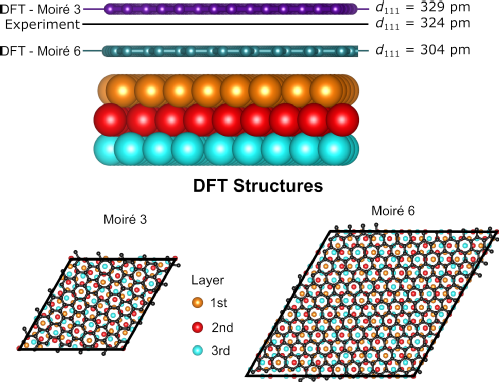Physics Department News
New paper published in Physical Review Letters
Professor Reinhard MaurerLink opens in a new window has recently published his paper in Physical Review Letters titled Structure of graphene grown on Cu(111): X-ray Standing Wave Measurement and Density Functional Theory Prediction'Link opens in a new window
The project brings together theoretical condensed matter physics and materials modelling (Prof. Reinhard Maurer) and experimental surface science techniques, particularly X‑ray synchrotron characterization (Dr David Duncan, Diamond Light Source), with an aim to utilise a recently developed method to grow ultra-clean, close-to-ideal graphene to accurately determine the structure of graphene at a metal surface.
The goal of the project was to understand the effect of graphenes orientation, with respect to the surface, on the adsorption structure. The orientation of two-dimensional films can play a significant role in the material properties of the films and varying the orientation of stacked layers of two-dimensional films may result in emergent quantum phenomena. Therefore, a clear structural determination is an important prerequisite to study quantum materials.
Results show that the lattice mismatch between graphene and the metal surface strongly influences the adsorption height. Further, it is shown that height variations of atoms within a single graphene sheet alone are not enough to explain the experimental adsorption structure of graphene on Cu(111).

Image shows side view and top view of ball-and-stick model structures of graphene adsorbed on Cu(111) surface. The picture indicates different superstructures and the predicted and measured adsorption heights.
Reinhard says: “Our initial simulations of the graphene structure were not consistent with experiment. Our structures were perfectly flat, but the experiment suggested that a minor level of height modulation of the atoms is present. Only by accounting for multiple large-scale superstructures of graphene with different random orientations at the surface were we able to capture these height differences. Without substantial supercomputing resources at the UK's national supercomputer ARCHER2, we would not have been able to resolve this."
In addition to using the UK’s national supercomputer, ARCHER2, to perform the simulations, the experimental measurements took place at Diamond Light Source, the UK’s national synchrotron. Diamond is the only place in the world that is currently equipped to regularly perform adsorption height measurements using a technique called X-ray standing waves that provides structural details with a precision of a few picometers (10-12 m).
